I discovered location-less caches. The objective is to find, photographic and document an object or place. Here are some examples:
GC49C7 - Railroad and
Train Locationless: Steam Locomotive
Document a surviving steam locomotive.
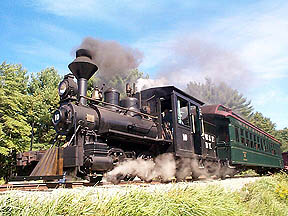
Locomotive #10
Wiscassett, Maine
N44 03.634
W069 37.422
Locomotive #10 from the Wiscasset, Waterville, and Farmington Railway Museum. The WW&F was a two-foot gauge common carrier railroad that operated in the early part of the 1900's, up until 1933 when the railroad ceased operations. The line ran from Wiscasset in the south, to Albion and Winslow in the north. The Museum is located at the site of the old Sheepscot station, with mainline track running north from Cross Road, on the original roadbed. The Museum is open from 9 - 5 on Saturdays year round, Sundays between Memorial Day Weekend and Columbus Day Weekend, and other times by chance or appointment. Trains operate only on weekends. Visit their website www.wwfry.org for more information.
#10 has an interesting history. It was built in 1904 by Vulcan, in Wilkes-Barre Pennsylvania, as a 30" gauge locomotive for Louisiana sugar plantations. At one time named the High Pockets, this engine saw service with at least 3 sugar plantations, including Sterling Sugars, Inc. and Westfield Plantation. This was Westfield's 4th locomotive, and went out of service there in 1958. It was sold to the Edaville Railroad, in South Carver, Mass.
Edaville regauged it to 24", gave it the number 5, and put it in service in the Pleasure Island amusement park in Wakefield, Mass. After the park's closure in the late 1960's and was put into storage until sold to WW&F in 1998. Following the tradition of railroads everywhere, the locomotive was relettered and renumbered, given #10 on the WW&F. The first steam-up on the WW&F took place on December 18, 1999.
GC51EF - Ship out of water
Find a big boat out of the water that has been permanently changed
into a place of business or other type of attraction.
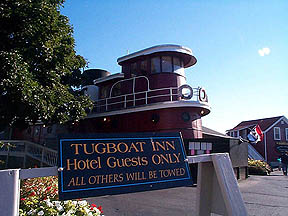
The Tug Boat Inn
Boothbay Harbor, Maine
N43 50.977
W069 37.751
GC4A5A - Railroad and
Train Locationless: Depots
Document a railroad depot that is now used for another
purpose.
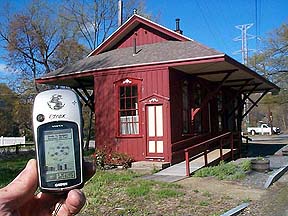
Wayland Depot
Wayland, MA
N42 21.852
W071
21.713
On the Central Mass rail line in Wayland, MA. The Central Mass. rail line was started in 1868 to operate between Boston and Northampton. In 1884, financial problems led to bankruptcy. A concerned Waltham citizen suggested at that time that, "the rails be removed and the ties planked over to create a bike path"! Service on the ill-fated Central Mass. line ended for good in 1971.
Today, there is a renewed effort to turn the line into a bike path. The western end of this rail line has been converted to the Norwottuck Rail Trail which runs from Amherst to Northampton. For recent information concerning the eastern end, visit www.wachusettgreenways.org or tdc-www.harvard.edu/massbike/bikeways.
The Wayland Depot was built in 1881. It is currently used as a craft and antique shop. Run by volunteers, the proceeds are used to fund non-profit organization in the town.
GC52AE - Shipwreck
Document a shipwreck anywhere in the world.
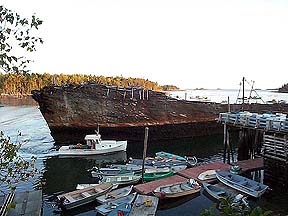
Cora F. Cressy
Bremen, ME
N43 59.071
W069 24.891
My search for this wreck started at the Maine Maritime Museum (www.bathmaine.com) in Bath, Maine (N43 53.648 W69 49.008). The museum is on the grounds of the Percy & Small shipyard, the builder of massive five-masted schooners. After touring the grounds, I longed to see such a ship. Unfortunately, the only P&S schooner to be found in Maine is the wreck of the Cora F. Cressy. Armed with only a rough location and my GPS, I took off. Thirty-seven miles later, I found her with the help of some locals.
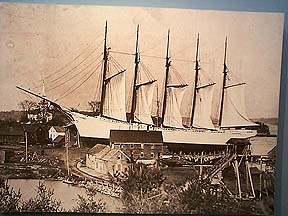
The Cora F. Cressy was a massive five-masted schooner built in 1902. She was 2499 tons (GRT), 273 feet long, and could carry some 4000 tons of coal. She was of very stout construction, with very high bows, but was a good sailer, and fast. After surviving a 1924 gale that claimed two other schooners (including the mighty six-masted Wyoming), she was known as "Queen of the Atlantic Seaboard". In 1928 she lost her sails in a gale and was laid up; she was expensive to operate and the repair costs could not be justified.
In 1929 a deckhouse was built over her main deck and she became a nightclub at Gloucester. In 1935 she was towed to Providence to continue her service as a nightclub, but returned north to Boston before the end of the year. Soon after the nightclub closed and she lay abandoned at the pier; in 1938 she was sold to become a lobster storage facility at Medomak, Maine. She was completely gutted out and towed back to Maine in March of 1938. Once she arrived at Medomak the idea was to store live lobsters in her vast hulk; this required that many holes be cut in her hull to circulate water through her holds. However, her stout construction prevented completion of this plan; it was simply impossible to cut enough holes to provide sufficient water flow. Instead she was scuttled along the riverbank as a breakwater, and the lobster pound built between her hull and the shore.